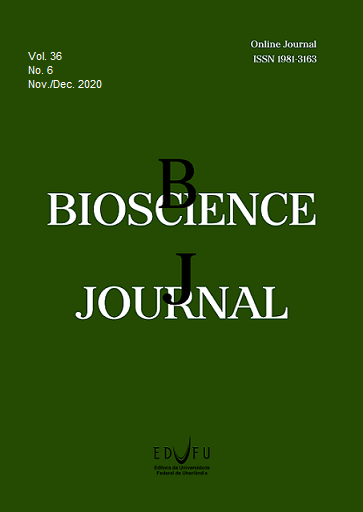Wheat growth and nutrient uptake after phosphorus and potassium applications in saline-sodic field of semi-arid region
DOI:
https://doi.org/10.14393/BJ-v36n6a2020-42494Keywords:
wheat growth, phosphorus, potassium, saline-sodic soil, semi-arid landAbstract
Nutrient deficiency is important limiting factor of saline-sodic soils which results in declining crop production in arid climates. The study investigated wheat response to phosphorus and potassium in saline-sodic field of Kohat, Pakistan. The K2O was applied at 0(K0), 75(K1), 150 (K2) kg ha-1 as K2S04 and P2O5 at (0(P0), 60(P1), 120(P2) kg ha-1 as (NH4)2HPO4 in three replications under two-factorial randomized complete block (RCB) design. Both treatments significantly enhanced wheat grain (118%) and dry matter yield (60%) at P2K2 compared to control. The P treatments significantly affected leaf P, Mg, SO4, Ca:P, SO4:P ratios and soil P, Ca:P, Cl:P and SO4:P ratios, while K on leaf K, Na, Ca, SO4concentration, K:Na, K:Ca, SO4:P,Ca:P ratios and soil pH, Na, K, Ca, SO4 concentrations, SAR, Na:K, Ca:K and Na:Ca ratios. Leaf Na was decreased to 85.3 mmol (+) kg-1 at K2 compared to 105.3 mmol (+) kg-1at P2K0. Negative correlation (R2=0.906) of leaf K:Na was found with Leaf Na concentration. Correlation of dry matter was more positive (R2=0.851) with leaf K:Na than grain yield (R2=0.392). It is concluded that K and P addition might be beneficial for improving crop nutrition and wheat yield in saline-sodic soils.
Downloads
Published
Issue
Section
License
Copyright (c) 2020 Zahid Hussain, Riaz Ahmad Khattak, Ping An, Yang Shao, Muhammad Irshad

This work is licensed under a Creative Commons Attribution 4.0 International License.





